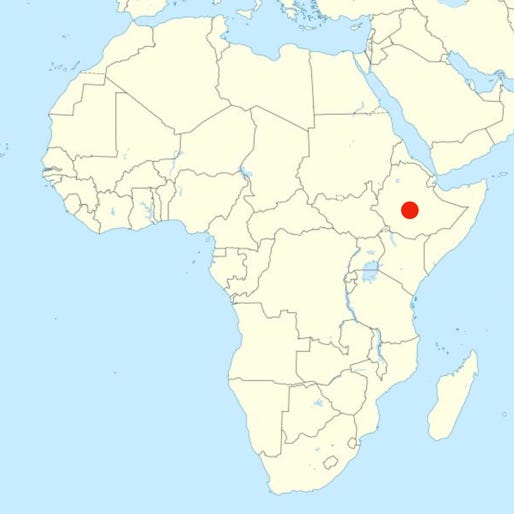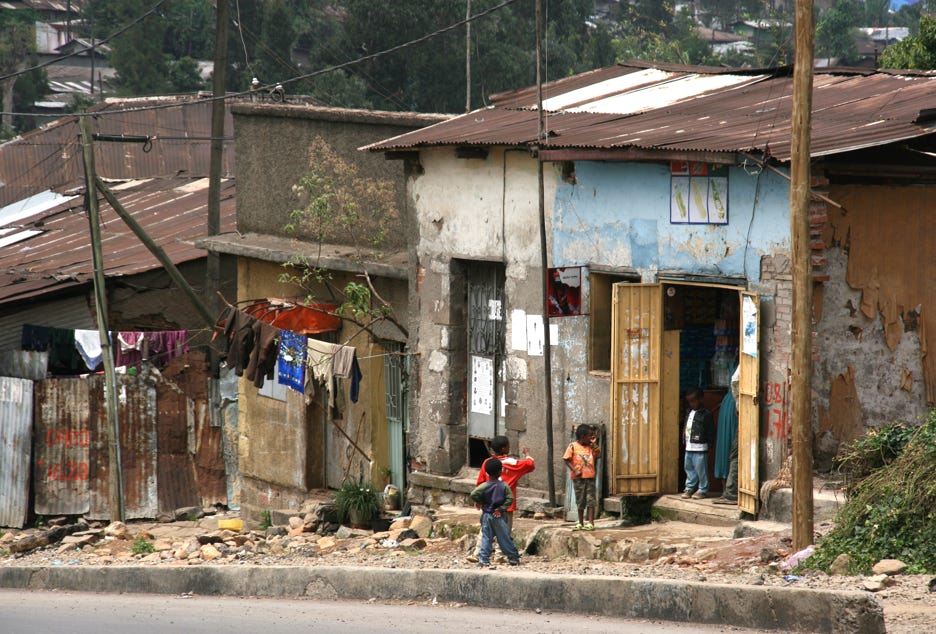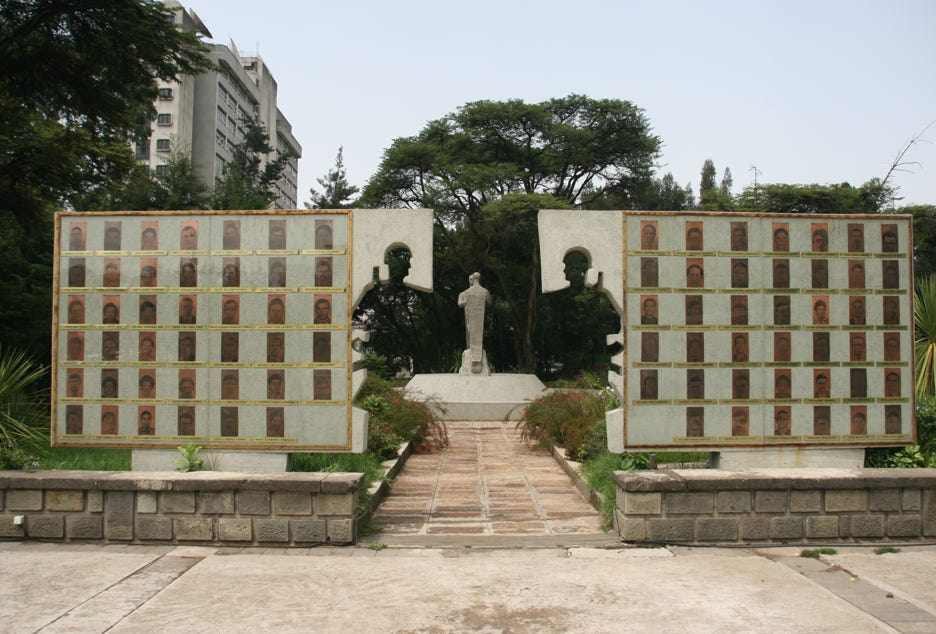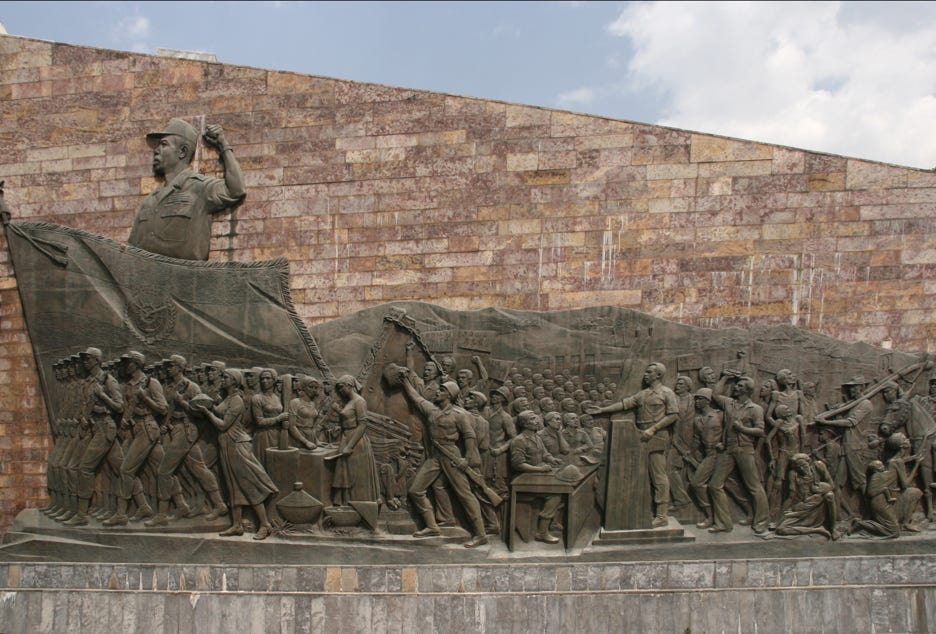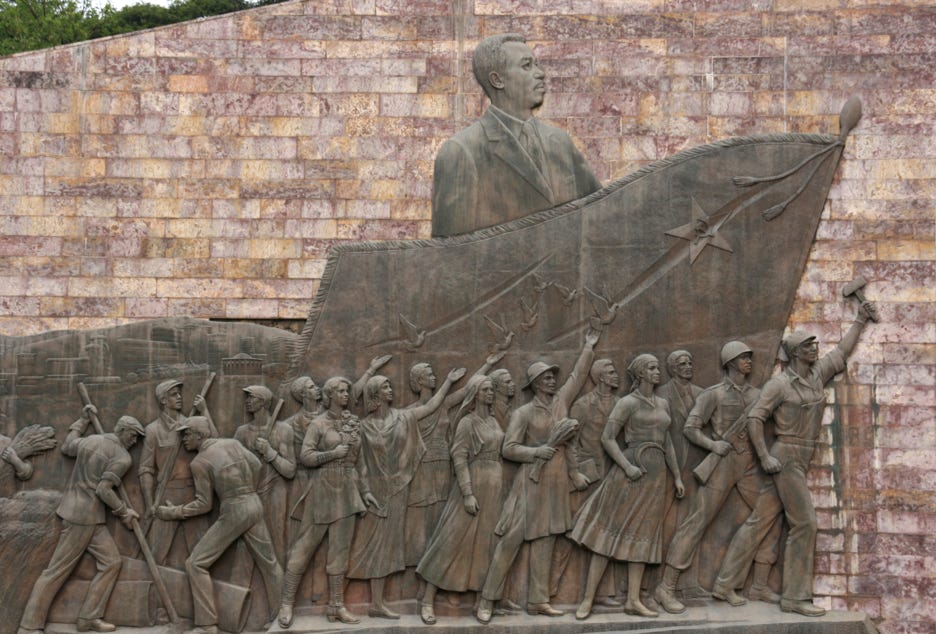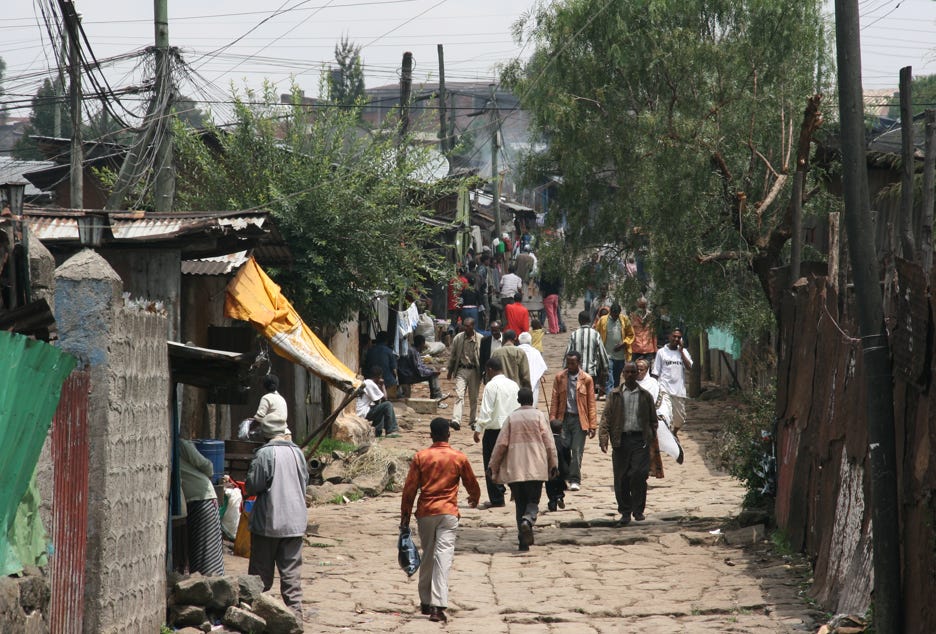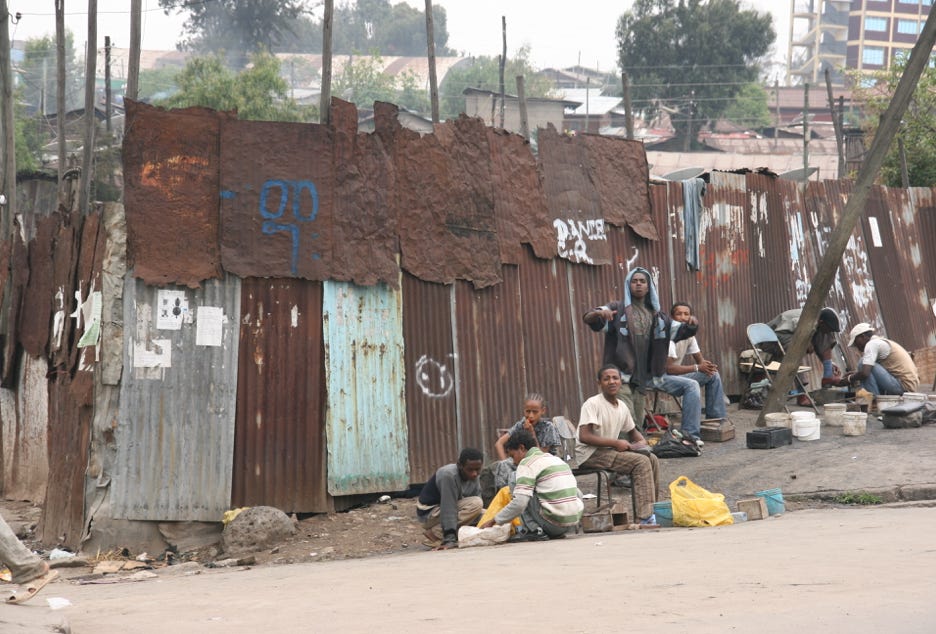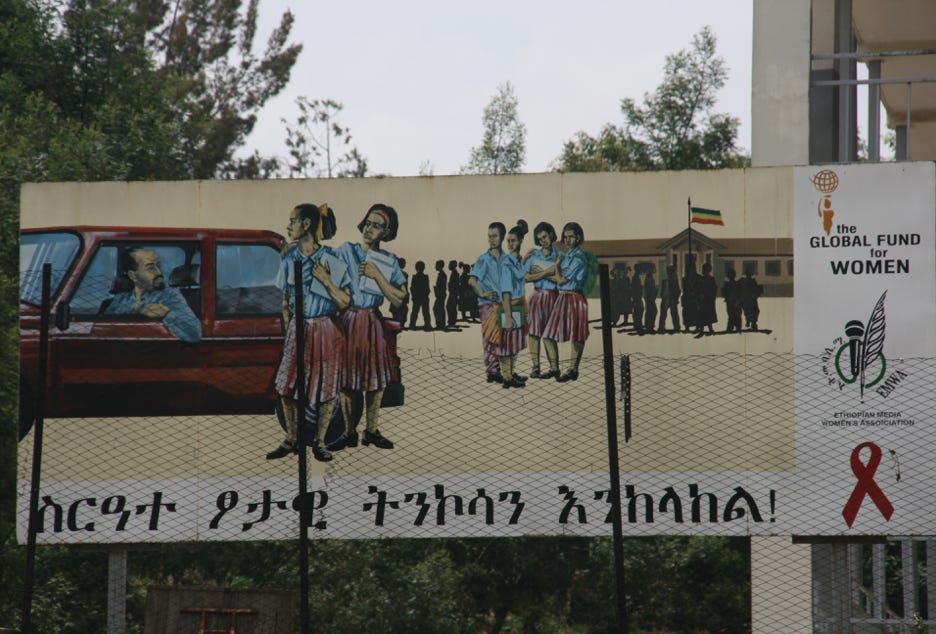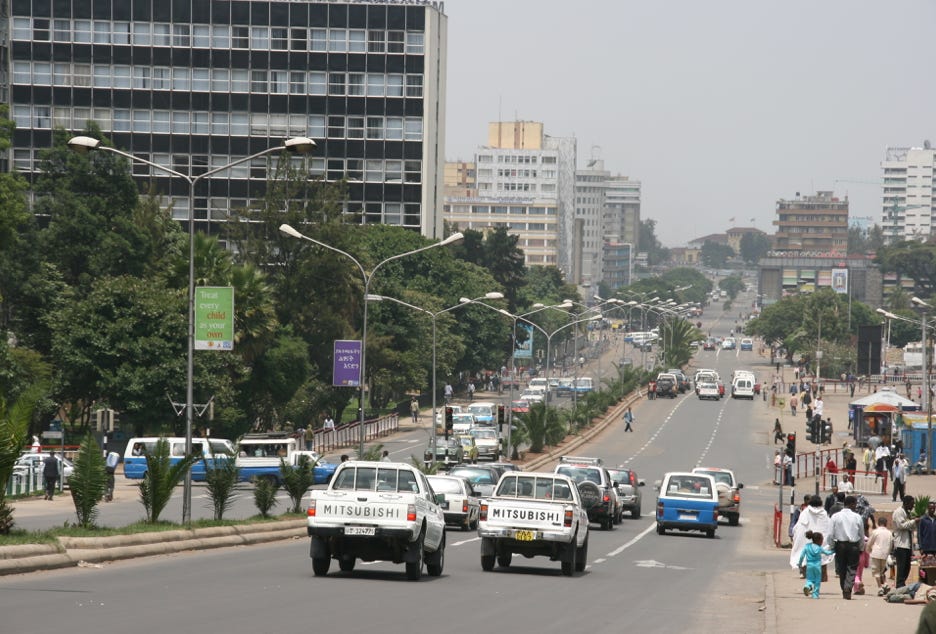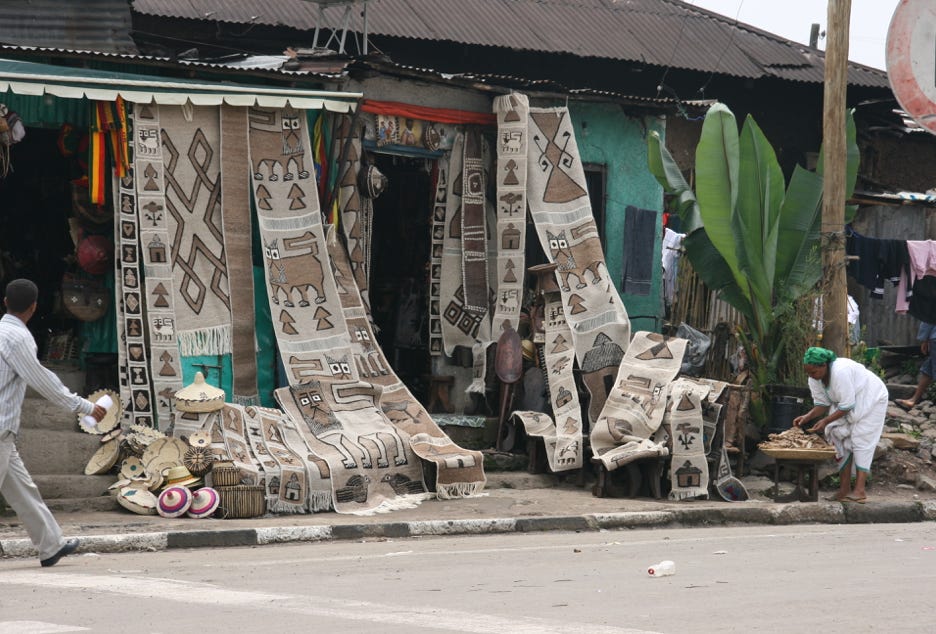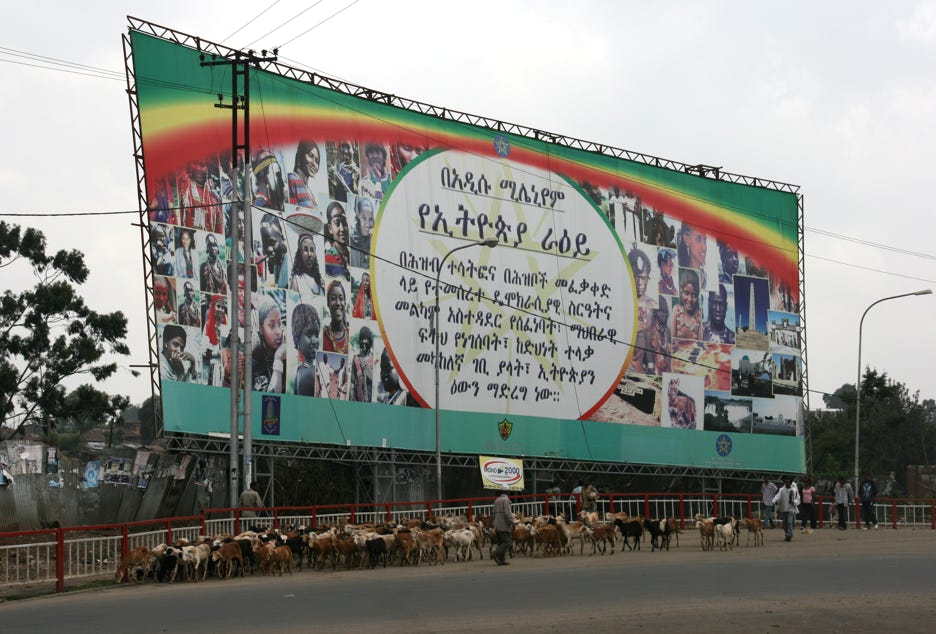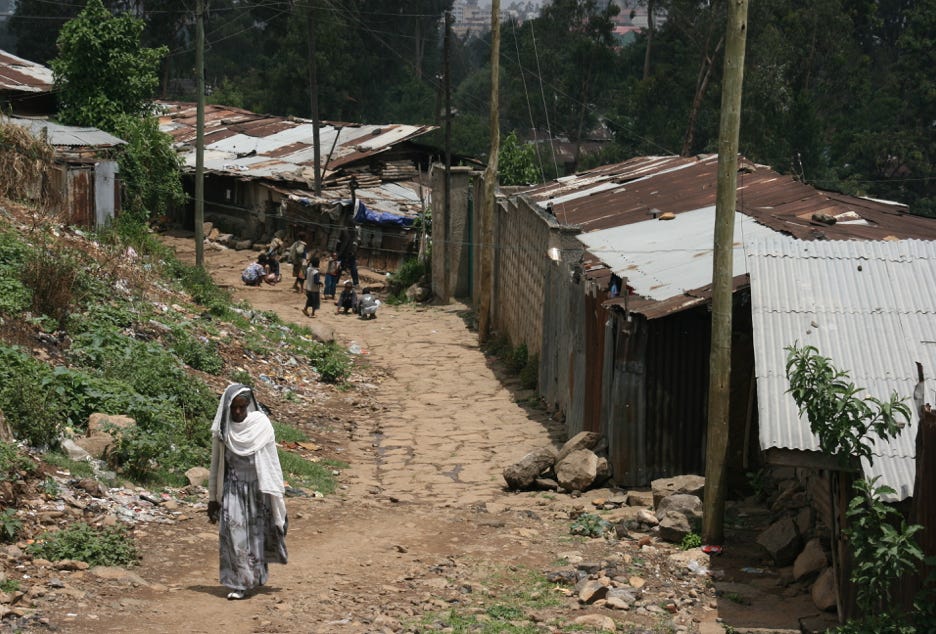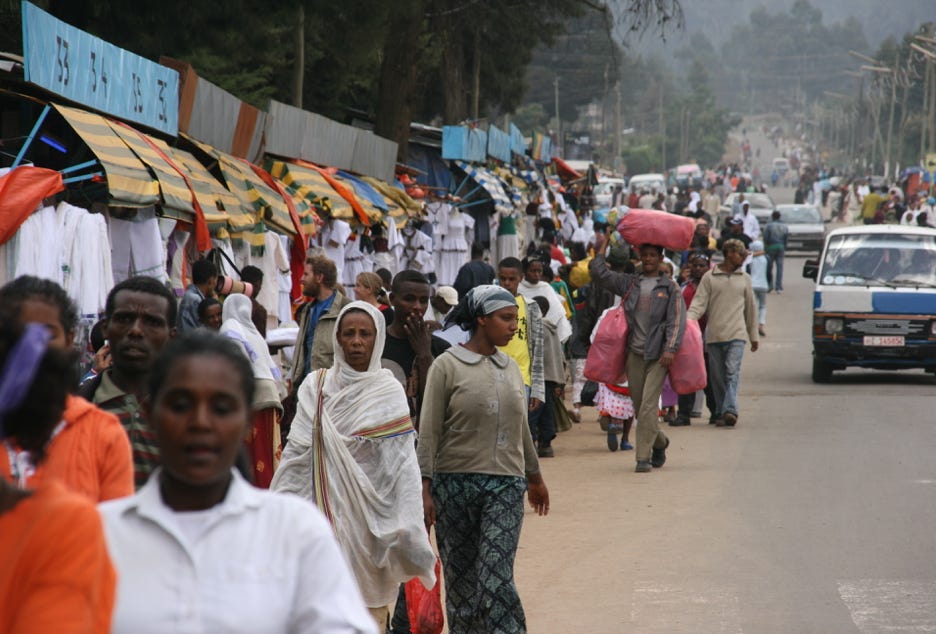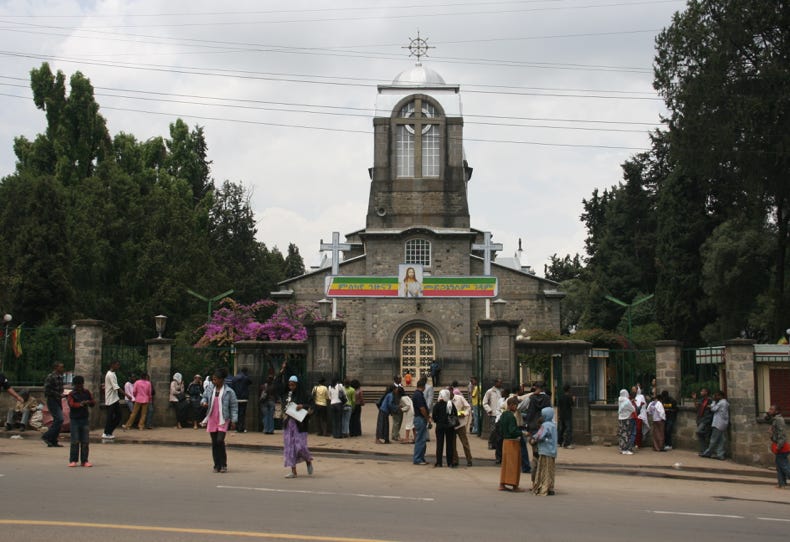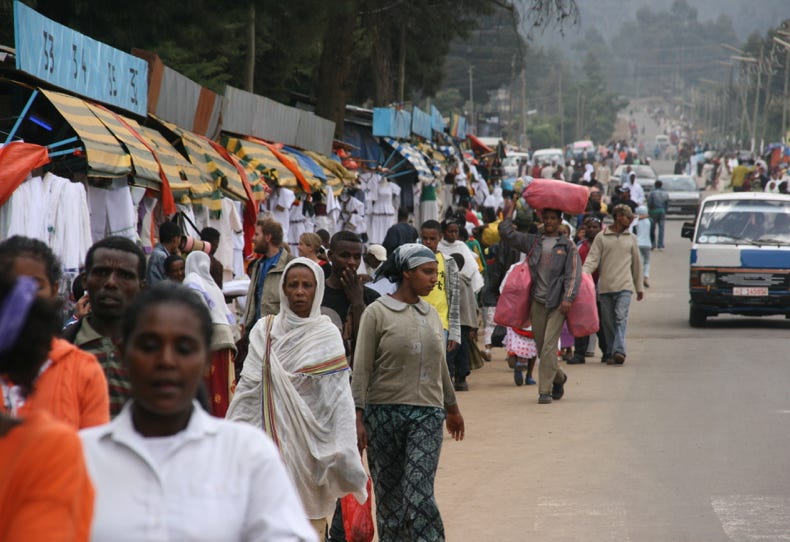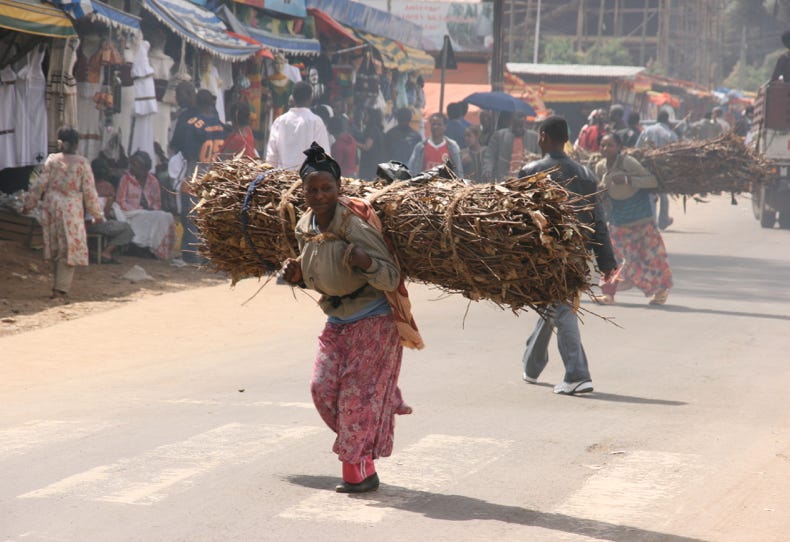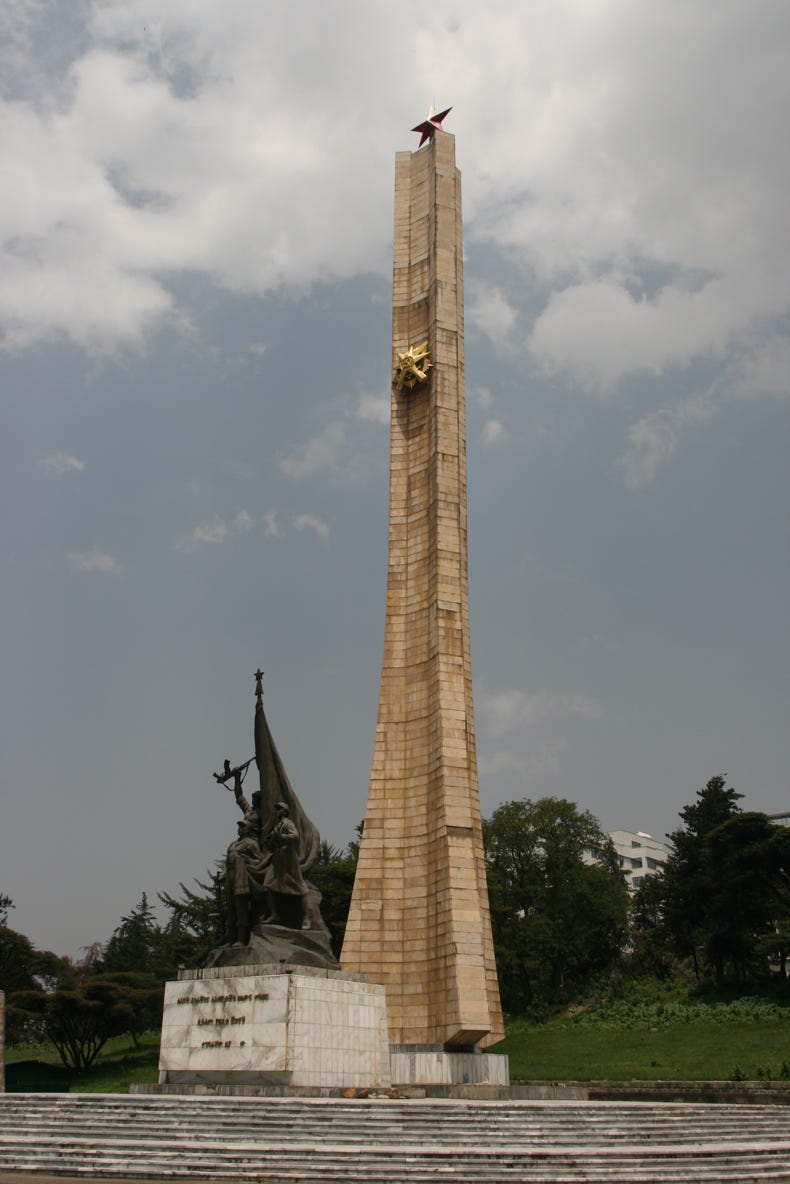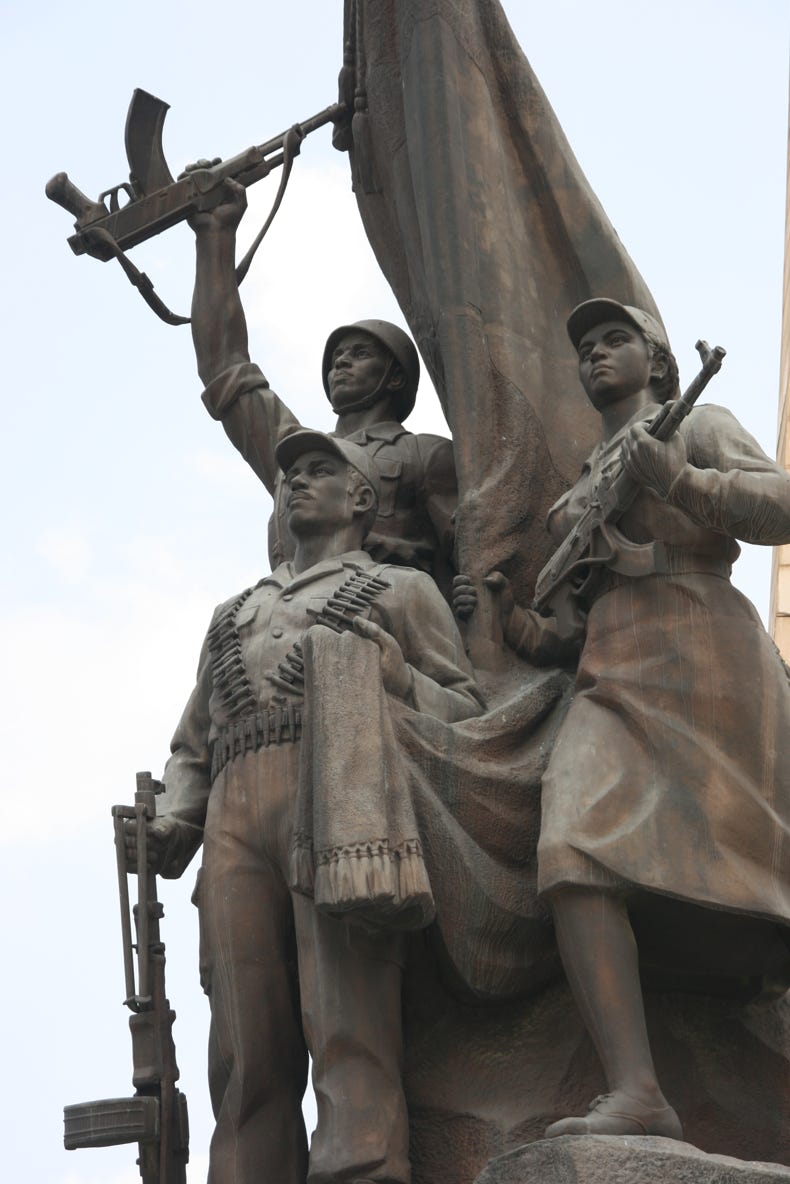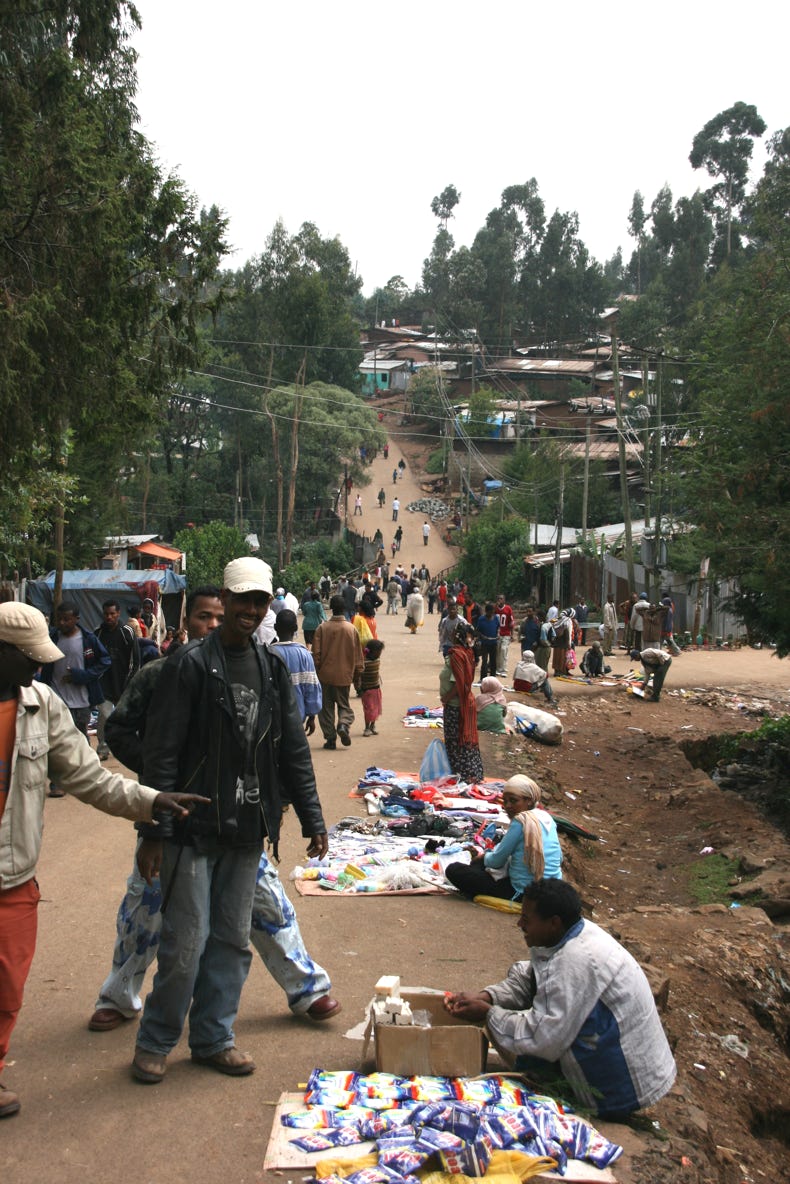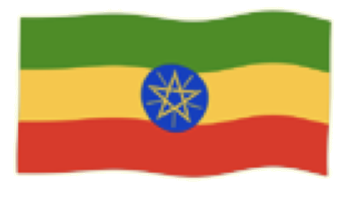

Those who know the way I plan my intense travel itineraries won’t believe this, but we had nothing scheduled for today apart from resting and doing a bit of light sightseeing. I still set my alarm, of course, because I didn’t want to miss breakfast, but by the time the alarm rang at 8:00 am, Andy and I were already stirring in response to the bright sunlight streaming in through the windows of our room.
In the spirit of enjoying a restful Sunday, we took our time getting ready and went downstairs to breakfast at about 9:00 am. Even breakfast in a place like Addis Ababa can have its surprises - beyond the obvious ones of trying to work out what some of the food is. For example, I would estimate that about one-third of the other guests in the large dining room were American or European couples who seemed to have just collected an Ethiopian child or baby for adoption. In some cases, the happy couples seemed to have taken on two or (in one case) three children. I had heard that adopting African children was ‘fashionable’ in some circles, but the reality of the scale of these adoptions does not hit home until you see all the white couples getting to know ‘their’ new children in a hotel restaurant in Addis Ababa.
The other ‘surprise’ this morning was especially for Andrew. We really had a hard time getting a cup of tea (for Andrew) or coffee (for me), both of which had to be served by the staff even though everything else was buffet-style. We had asked three times, and we had even finished our breakfast, but still there was no sign of the tea of coffee. And then it came – a nice cup of coffee with milk for me, but Andrew was served a saucer with a tea bag on it. No cup. No water. He was a bit disappointed by this, as it was not quite what he had in mind when he ordered his tea, so we asked yet again. There was another very long wait, during which time I finished my coffee, before Andy finally got his cup and hot water, delivered simultaneously with the bill.
After breakfast, we spent a little while washing clothes in preparation for our week in the south of Ethiopia that is due to begin tomorrow - the forecast is wet weather all week, so we wanted to have a ready supply of clothes. Actually, to be precise, every time I have used the word “we” in this paragraph, I really should have written “I” :-)
Having finished washing the clothes, we decided to use the sunny weather to explore Addis Ababa on foot. We resolved to try and see four places before the inevitable afternoon rains began, and we almost met our target. First stop was Meksal Square, situated just a couple of hundred metres from the hotel. This was the same square with the 16-lane road through the middle that we had been exploring last week when the heavy rains began, and we wanted to see it more fully than last week’s weather permitted. It was also the same place where yesterday’s photo of the grotesque dove in overcast conditions was taken. The experience this morning was quite different, with clear sunny weather, bright lighting, and lots of activity with children playing football on the paved surface, together with throngs of people walking, sitting, jogging, and simply enjoying the sunshine.
From Meksal Square, we walked a little more than half a kilometre along Ras Desta Damtew Street to the Derg Monument. We had visited this area briefly last week, but this time with the sun shining, we entered the park that contained the monument. This park looked like something uplifted from North Korea or East Germany, and was a memorial to Ethiopia’s painful socialist era following the overthrow of Emperor Haile Selassie in 1974 until 1991. This era coincided with a period of war with Somalia, a tragic drought and famine, war with the separatist movement in Eritrea and a series of failed policies to promote rural collectivisation.
The centrepiece of the Derg Monument park was a tall obelisk topped with a red star and decorated with a golden hammer and sickle. At the foot was a sculpture in socialist realist style glorifying the revolutionary spirit of the workers, soldiers and peasants, flanked by two huge sculptures that could have been found in any Chinese city during the Cultural Revolution (or North Korea today) if it were not for the different ethnicity of the figures. Flanking each side of the park were gates into quiet parklands that were shaped like missing soldiers, surrounded by photographs of revolutionary martyrs. The whole park was a surprisingly well executed and deeply moving memorial.
Our third destination was a further one kilometre walk from the Derg Monument, and we approached it with some trepidation. We were heading to the area known as Merkato, a crowded zone of markets, shanty housing and narrow laneways whose mere mention always brought the comment “Be Careful!”. The area is famous for its pick-pocketing, and several people had warned us to leave all our valuables behind before going there (which I did), to be on guard, and to enter only in the company of another person, and so on. I had read about scams where a person does something to cause alarm, and while you are recovering from the surprise, his friends have bumped into you and emptied your pockets. I had read about another scam where a local person squirts liquid manure on your shoes as you walk through, and then in the resulting confusion, removes your valuables before showing you to his friend who runs a shoe cleaning business.
So what was the attraction of going there? I had heard it was Africa’s largest market, full of colour and action (though much less so on Sundays), where anything could be bought from camels to Kalashnikovs - both of which could be tried before buying! It sounded wonderfully photogenic.
It was quite an experience! Even as we entered the Merkato, we were surrounded by a group of young boys who started trying to distract us in various ways. Fortunately they soon lost interest, but a more worrying figure emerged in the form of a very drunk (or maybe highly drugged) man who decided to take a special interest in Andrew and me. He reached down and picked up a 4 metre long bamboo pole to swing around and hit us, but then he lost his balance as the bewildered locals looked on. However, he persisted in following us, shouting things that we couldn’t understand before reaching a wood cutter’s stall, at which point he picked up a heavy block of freshly chopped solid wood, measuring roughly 1 metre by 25 cm by 10 cm and started swinging it towards us. Needless to say, we moved on fairly quickly, and feeling we had probably got as good an understanding of Merkato as we were likely to get, we moved out onto a main road and away from the depths of Merkato.
Our fourth and final destination was much further away, perhaps 8 to 10 kilometres walk. Although neither Andrew nor I were particularly fond of museums (especially following our recent experience in Aksum), the guidebook’s description of Addis Ababa’s Ethnographical Museum was sufficient to entice us to undertake the long walk, partly to get some exercise before starting the long drive south tomorrow, and partly because we thought we might see some interesting things.
We were right on both points. We saw some classic sprawling shanty settlements, some interesting shops, several herds of goats crossing busy traffic intersections, women carrying fuelwood, busy churches, the university, interesting signs, fascinating people, the high security of the US Embassy, smoky vehicles, and lots more. I have included a few images here to give you some idea of the diversity of the sights we encountered.
Having walked a total of about 16 kilometres, there was, however, one small frustration. We never managed to find the Ethnographical Museum. We were following the map in the Lonely Planet Guide, and although most of the streets were found (sometimes in the wrong places if the map was to be believed), we never found the street where the museum should have been, we never found a sign for the museum, and no-one we asked had any idea about its whereabouts.
By 3:00 pm, the dark grey afternoon rain clouds were starting to build up and we decided to return to our accommodation. We found a taxi driver willing to take us to the hotel, negotiated the fare, and off we set in an old blue and white, weather-beaten, traffic-beaten Lada. As most of the journey back to the hotel was downhill, the driver decided to save fuel by coasting with the engine turned off for much of the trip. Even so, he still felt the need to stop at a petrol station to buy 2 litres of petrol so that we could finish the journey. Although the sun had still been shining brightly when we started the journey, within 10 minutes the afternoon downpour had begun, including a couple of minutes of hail.
Reaching the hotel at about 3:20 pm, we decided to have a light liquid lunch of Coke and coffee, which were very welcome after the long walk. It was great simply to sit down and relax! The subsequent two and a half hours were not quite so relaxing, however, as a new batch of 67 work-related e-mails suddenly arrived as the College’s server sprang back into action in Hong Kong (it had been down yesterday afternoon when I had handled all the other e-mails that were on G-mail).
We had dinner this evening in our hotel, and I think it was one of the best meals we have enjoyed so far on the trip. After some mulling through the menu, we both decided to have the same three-course meal - French onion soup, followed by grilled Nile perch, finishing with creme caramel. The dinner included a couple of hot bread rolls, drinks and then tea/coffee at the end, all for a cost of just under US$7 each plus taxes - a splurge by Ethiopian standards, but great value for us.
All in all, it has been a great day, despite the somewhat adventurous interlude in Merkato. Walking about 16 kilometres through the streets of Addis Ababa has given us a much better insight into everyday life in Ethiopia’s capital than any tour or any book could ever do. I feel as though it has been a genuine privilege to be out on the streets today.
